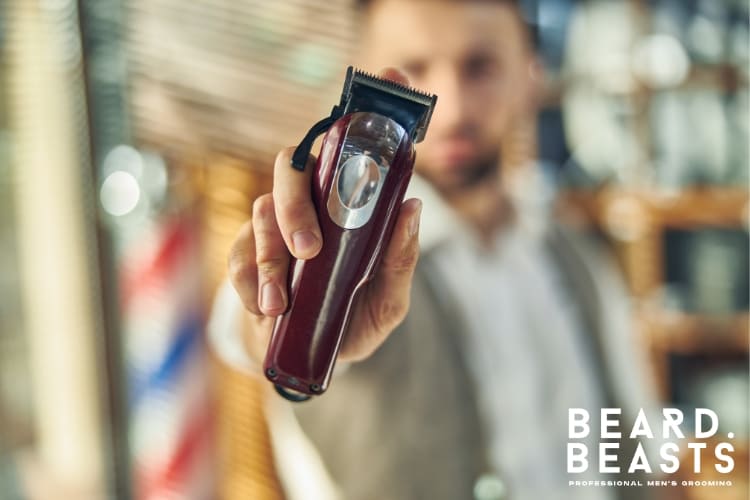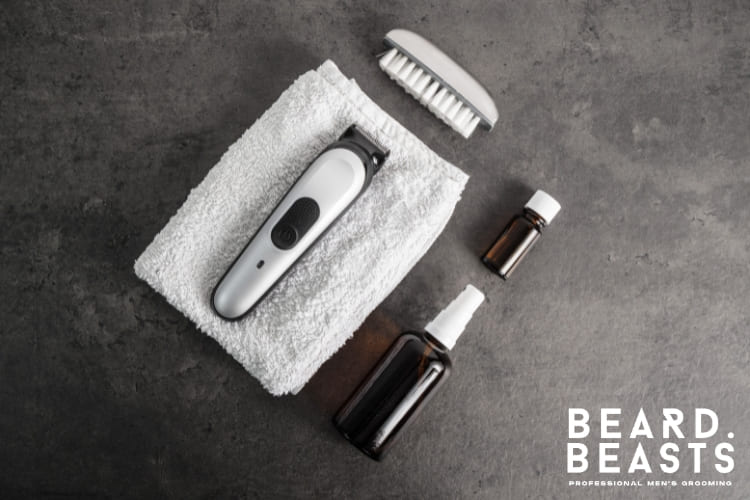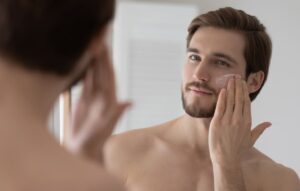Learning how to clean hair clippers is the key to preventing snags, irritation, and those dreaded bad haircut days. Dirty clippers aren’t just unpleasant; they harbor bacteria, impacting both your clippers’ performance and your skin’s health.
Whether you’re a pro barber or a DIY enthusiast, this guide provides a detailed, step-by-step process to keep your clippers in top condition. Let’s dive in!
Why Cleaning Hair Clippers is Essential
Cleaning your hair clippers isn’t just about appearances; it’s about hygiene, performance, and longevity. Mastering how to clean hair clippers is a crucial skill for any barber or at-home enthusiast.

Hygiene: Protect Your Skin and Scalp
Dirty clippers are a breeding ground for bacteria and fungi. Hair, skin cells, and oils trapped in the blades create a haven for germs that can cause:
- Infections: Transfer of bacteria and fungi can lead to scalp infections, irritations, and even ringworm.
- Skin Irritation: Grime and hair buildup can cause clippers to snag, leading to nicks, cuts, and razor burn, increasing infection risk.
- Allergic Reactions: Dirty clippers can trigger allergies, causing redness and itching.
Regular cleaning, and knowing how to disinfect hair clippers, is essential for your health. Disinfecting after every haircut is best practice.
Performance: Sharp Cuts, Long-Lasting Clippers
Clean clippers simply work better and last longer. Here’s why:
- Efficiency: Clean blades cut smoothly and quickly. Clogged blades cause uneven cuts and strain the motor.
- Longevity: Regular cleaning prevents rust and corrosion, extending the life of your clippers and saving you money.
- Smooth Operation: Lubricating after cleaning reduces friction, preventing overheating and ensuring a comfortable cut.
Proper clipper care protects your health and ensures peak performance. Keep reading to learn the step-by-step process of how to clean hair clippers effectively.
Tools and Materials Needed
Gather these essential tools to make cleaning your clippers quick and effective. Here’s your kit for mastering how to clean hair clippers:

Your Essential Clipper Cleaning Kit:
- Cleaning Brush: For removing loose hair and debris (usually included with clippers).
- Blade Wash: A specialized solution to deep clean blades. Choose one designed for clippers.
- Disinfectant Spray: Kills bacteria and viruses. This is vital for disinfecting hair clippers. Use a hospital-grade spray safe for blades, such as Barbacide.
- Clipper Oil: Lubricates blades, reduces friction, and prevents rust. Apply after every cleaning. Wahl Clipper Oil is a great option.
- Soft, Lint-Free Cloth: For drying clippers after cleaning.
- Screwdriver (Optional): For disassembling clippers if needed (check your manual).
With these tools, you’re ready to clean your clippers effectively, ensuring they stay in top shape for great haircuts every time.
How To Clean Hair Clippers: Step-by-Step Guide
Cleaning your hair clippers may seem like a chore, but it’s easier than you think. This step-by-step guide will show you how to clean hair clippers like a pro, ensuring they stay in top condition for a perfect cut every time.
Preparation: Safety First
- Unplug: Always unplug your clippers before cleaning to prevent any risk of electric shock.
- Disassemble: Carefully detach the blades and any other removable parts. Refer to your clipper’s manual for specific instructions.
Blade Cleaning: The Deep Clean
- Brush Off Hair: Use your cleaning brush to thoroughly remove all loose hair from the blades. Pay close attention to the gaps between the teeth.
- Blade Wash: Submerge the blades in a blade wash solution for 2-3 minutes. This will dissolve any stubborn grime, oil, and product buildup. Swish the blades around gently in the solution for a more effective clean.
- Dry Thoroughly: Pat the blades dry with a soft, lint-free cloth. Then, let them air dry completely. It is very important to make sure they are completely dry to prevent rust.
Body Cleaning: Wipe and Disinfect
- Wipe Down: Use a damp cloth to wipe the entire body of the clippers, removing any stray hairs or dirt.
- Disinfect: Spray the body of the clippers (and any non-removable parts) with a disinfectant spray. This critical step eliminates bacteria and germs, and is an important part of learning how to disinfect hair clippers. Don’t forget to spray the handle and any areas where your hands make contact.
Lubrication: Keep it Smooth
- Apply Oil: Once the blades are completely dry, add 2-3 drops of clipper oil to the teeth and along the contact points where the blades meet.
- Reassemble: Carefully put your clippers back together, ensuring all parts are securely in place.
Final Check: Test Run
Test: Turn your clippers on for a few seconds to allow the oil to distribute evenly. This also lets you check that everything is running smoothly.
Pro Tips for Clipper Care:
- Clean After Every Use: This prevents buildup and keeps your clippers hygienic.
- Use the Right Products: Invest in quality blade wash, disinfectant, and clipper oil.
- Store in a Dry Place: Moisture is the enemy of clippers. Store them in a dry, cool area.
By following these steps, you’ll master how to clean hair clippers effectively. Regular cleaning is an investment in your clippers’ performance, longevity, and your overall health.
Tips for Maintaining Hair Clippers
Proper maintenance is key to keeping your hair clippers running smoothly and extending their lifespan. Beyond knowing how to clean hair clippers, these pro tips will help you maintain your clippers like a seasoned barber.
Regular Cleaning and Storage
Make it a habit to brush off hair and disinfect your clippers after each use, preventing buildup and ensuring hygiene. Even with daily maintenance, schedule regular deep cleanings. Store your clippers in a dry place, ideally in a protective case, away from humid environments like bathrooms.
Lubrication
Oil your clippers regularly, applying it after every cleaning and before each use. This reduces friction, prevents overheating, and ensures a smooth cut. Usually, 2-3 drops are sufficient.
Avoid Common Mistakes
Never submerge your clippers in water; use appropriate cleaning solutions. Always follow the manufacturer’s instructions when taking your clippers apart. Neglecting your blades can lead to poor performance and skin irritation, so make cleaning and disinfecting a priority.
Mastering these maintenance tips, along with knowing how to clean hair clippersproperly, will ensure your clippers deliver top-notch performance for years to come.
Troubleshooting: Solutions for Common Clipper Problems
Even with care, your hair clippers might encounter a few hiccups. This troubleshooting guide will help you diagnose and fix common issues, keeping your clippers in prime condition
Dull Blades
If your clippers start pulling or tugging at hair instead of cutting cleanly, or if you notice uneven, patchy results and an increase in motor noise, your blades are likely dull. In this case, you can have your blades professionally sharpened. If sharpening doesn’t solve the problem or if the blades are visibly damaged, it’s time to replace them. Refer to your clipper’s manual for the correct blade type and replacement procedure.
Overheating
If your clippers become uncomfortably hot during use, the first thing to do is to immediately turn them off and unplug them to let them cool down. Overheating is often caused by hair and debris buildup or lack of lubrication. Clean your clippers thoroughly, removing any hair or debris, paying close attention to the blades and the area around the motor. After cleaning, be sure to lubricate the blades with clipper oil to reduce friction.
Strange Noises
Unusual noises like buzzing, grinding, or rattling can indicate various issues. First, check for any loose screws or components and tighten them. If the noise persists, it could be due to hair or debris trapped inside the clippers.
Try disassembling, cleaning, and reassembling the clippers, making sure to lubricate them properly afterward. A lack of lubrication can also cause grinding or buzzing sounds, so ensure you’re oiling your blades regularly.
If you’ve tried these solutions and the problem persists, it might be time to consult a professional for repair or consider replacing your clippers.
Regular maintenance is key to avoiding these issues, so be sure you know how to clean hair clippers properly.
Conclusion: Mastering How to Clean Hair Clippers for Optimal Results
Taking care of your hair clippers is a crucial investment in their performance, longevity, and your overall grooming experience. By mastering how to clean hair clippers, you unlock the secret to consistently great haircuts and healthy skin.
Remember to clean your clippers after every use, preventing buildup by brushing off hair and disinfecting. Use a proper disinfectant spray and apply clipper oil regularly. Store your clippers in a dry place to protect them from damage. This ensures optimal performance, extends the lifespan of your clippers, and protects your skin from irritation and infection.
Following this guide’s step-by-step instructions on how to clean hair clippers and our maintenance tips will keep your clippers in top condition, delivering salon-quality results every time. Embrace these simple habits, and you’ll enjoy the long-term benefits of well-maintained clippers and consistently great haircuts.





